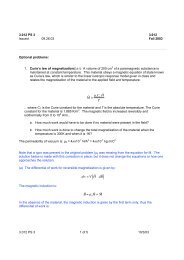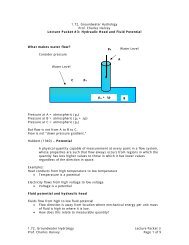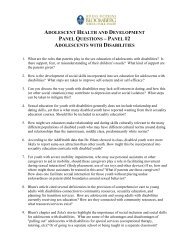1.72, Groundwater Hydrology Prof. Charles Harvey Lecture Packet ...
1.72, Groundwater Hydrology Prof. Charles Harvey Lecture Packet ...
1.72, Groundwater Hydrology Prof. Charles Harvey Lecture Packet ...
You also want an ePaper? Increase the reach of your titles
YUMPU automatically turns print PDFs into web optimized ePapers that Google loves.
<strong>1.72</strong>, <strong>Groundwater</strong> <strong>Hydrology</strong><br />
<strong>Prof</strong>. <strong>Charles</strong> <strong>Harvey</strong><br />
<strong>Lecture</strong> <strong>Packet</strong> #11: Solute Transport in <strong>Groundwater</strong><br />
Importance of Solute Transport in <strong>Groundwater</strong><br />
• Geologic questions: ion migration, ore deposition.<br />
• Environmental problems: contamination of drinking water by organic<br />
compounds and metals, radioactive waste disposal, saltwater intrusion.<br />
Drinking water standards<br />
• Dissolved compounds can be toxic and carcinogenic.<br />
• Safe Drinking Water Act directed EPA to establish MCLs (maximum<br />
contaminant levels)<br />
Typical values:<br />
=<br />
Contaminant MCL<br />
Trichloroethylene (TCE) 5 µg/L<br />
Tetrachloroethylene (PCE) 5 µg/L<br />
Vinyl Chloride 2 µg/L<br />
Benzene 5 µg/L<br />
Carbon Tetrachloride 5 µg/L<br />
Copper 1 mg/L<br />
Lead 0.05 mg/L<br />
Mercury 2 µg/L<br />
Arsenic 10 µg/L<br />
• Immiscible compounds serve as a source of dissolved groundwater<br />
contamination.<br />
Gasoline<br />
Impermeable<br />
Formation<br />
Immiscible<br />
PCE<br />
Ground Surface<br />
Dissolved<br />
NAPLs – non-aqueous phase liquids<br />
LNAPL – lighter-than-water NAPL (floaters)<br />
• For example, fuels: gasoline, diesel fuel<br />
• Plume forms on surface of water table<br />
• Migrates in direction of water table<br />
• Must be skimmed<br />
Impermeable<br />
Formation<br />
Methanol<br />
Miscible Ground Surface<br />
DNAPL – denser-than-water NAPL (sinkers)<br />
• For example: chlorinated hydrocarbons – TCE (1.46 sg), TCA (1.34), carbon<br />
tet (1.59)<br />
<strong>1.72</strong>, <strong>Groundwater</strong> <strong>Hydrology</strong> <strong>Lecture</strong> <strong>Packet</strong> 11<br />
<strong>Prof</strong>. <strong>Charles</strong> <strong>Harvey</strong> Page 1 of 8<br />
Ethylene Glycol
c<br />
• Can sink to bottom of aquifer to form pool<br />
• Can migrate down dip on aquifer bottom<br />
• Recovery difficult to impossible<br />
The problem:<br />
• Easy to contaminate<br />
• Low concentrations are bad<br />
• Substances can migrate with flowing groundwater<br />
• Hard to remove<br />
Dissolved Substances<br />
A solute is a substance dissolved in a liquid<br />
• Example: Chloride is a solute and water is the solvent<br />
• Concentrations measure in [Mass/Length 3 ] (mg/L)<br />
Representing data involving dissolved substances, C(x,y,z,t)<br />
Concentration History<br />
Time Distance<br />
Processes of Solute Migration<br />
c<br />
c<br />
Concentration <strong>Prof</strong>ile<br />
1) Advection – movement of the solute with the bulk fluid where it moves with<br />
the average velocity of the water (alone it is plug flow)<br />
• Recall from Darcy’s law we have linear average velocity:<br />
V = −<br />
K<br />
n<br />
e<br />
dh<br />
dL<br />
• Advective flux is simply velocity of water times the solute<br />
concentration Fadvec = VC<br />
Concentration History<br />
Time Distance<br />
c<br />
Concentration <strong>Prof</strong>ile<br />
<strong>1.72</strong>, <strong>Groundwater</strong> <strong>Hydrology</strong> <strong>Lecture</strong> <strong>Packet</strong> 11<br />
<strong>Prof</strong>. <strong>Charles</strong> <strong>Harvey</strong> Page 2 of 8
2) Hydrodynamic dispersion – spread of a solute plume involving the mixing<br />
of solute with native groundwater<br />
• Molecular diffusion – spread of solute molecules due to thermal motion<br />
(function of temperature)<br />
dc<br />
• Given by Fick’s Law Fdiff = − Dmolec dx<br />
o Where Dmolec is the diffusion coefficient in porous media (value less<br />
than that in water); D units [L 2 /T]<br />
o dc/dx is the concentration gradient<br />
c<br />
Concentration <strong>Prof</strong>ile<br />
Diffusion plus<br />
advection<br />
Time<br />
Get a narrow mixing zone where concentrations are smeared out.<br />
Important Observation – mixing zone seen in lab or field is much, much, much<br />
bigger than can be explained by diffusion alone.<br />
Lab experiments show:<br />
• Spreading exists<br />
• Spreading is more intense than due to diffusion<br />
• Spreading depends on groundwater velocity<br />
• Fick’s law applies, but the “D” is much bigger<br />
dc<br />
Fmech = − Dmech dx<br />
This is due to Mechanical Dispersion – the mixing that occurs because the porous<br />
media forces some solute molecules to move faster than others while following a<br />
tortuous path through pores of different sizes<br />
c<br />
Concentration <strong>Prof</strong>ile<br />
Mechanical<br />
dispersion plus<br />
advection<br />
Time<br />
<strong>1.72</strong>, <strong>Groundwater</strong> <strong>Hydrology</strong> <strong>Lecture</strong> <strong>Packet</strong> 11<br />
<strong>Prof</strong>. <strong>Charles</strong> <strong>Harvey</strong> Page 3 of 8
Velocity variations due to: for example –<br />
Fluid velocity<br />
profile<br />
Measurement<br />
Location<br />
Short<br />
Path<br />
Long<br />
Path<br />
Mechanical dispersion from lab fits: Dmech = α|V|<br />
Where α is the dispersivity with units of length [L]<br />
The Hydrodynamic Dispersion Coefficient consists of<br />
Dh = Dhydrodynamic = Dmechanical + Dmolecular<br />
NOT to be confused are:<br />
C<br />
C<br />
time<br />
time<br />
Dispersion – the spreading or mixing process<br />
Dispersion Coefficient – the D with units of [L 2 /T]<br />
Dispersivity – spreading or mixing parameter, a length, [L]<br />
The flux of solute is due to:<br />
• Advection (the main process)<br />
• Dispersion (hydrodynamic dispersion)<br />
dc<br />
Ftotal = VC + ( − Dmech )<br />
dx<br />
Solute Transport Equation<br />
Recall development of flow equation:<br />
Conservation of mass + some empirical law<br />
For transport of a nonreactive solute we use the above definition for flux as the<br />
empirical law giving in 1D:<br />
<strong>1.72</strong>, <strong>Groundwater</strong> <strong>Hydrology</strong> <strong>Lecture</strong> <strong>Packet</strong> 11<br />
<strong>Prof</strong>. <strong>Charles</strong> <strong>Harvey</strong> Page 4 of 8
∂ C ∂<br />
=<br />
∂ t<br />
2 C ∂C<br />
Dh −V 2<br />
∂ x ∂ x<br />
Change in<br />
concentration with<br />
time<br />
dispersion advection<br />
in uniform steady flow (one direction) the 2D transport equation is:<br />
∂ C<br />
=<br />
∂ t DL ∂ 2 C<br />
∂ 2<br />
x + T<br />
D ∂ 2 C<br />
∂ 2<br />
x −<br />
V x<br />
∂ C<br />
∂ x<br />
Where the longitudinal hydrodynamic dispersion coefficient is:<br />
DL = αL|V| and αL is the longitudinal dispersivity<br />
The transverse hydrodynamic dispersion coefficient is:<br />
DT = αT|V| and αT is the transverse dispersivity (much smaller than longitudinal<br />
dispersivity)<br />
Note: In 2D if flow is in two directions then you get 4 dispersion terms and two<br />
advective terms and the form of the “D”s is more complex)<br />
From a pulse injection you get a plume (a cloud) of solute that migrates via<br />
advection and spreads longitudinally (mostly) and transversely (a bit) – Mass is<br />
conserved.<br />
Map View Longitudinal Dispersion<br />
Concentration <strong>Prof</strong>ile<br />
Transverse Dispersion<br />
Distance<br />
<strong>1.72</strong>, <strong>Groundwater</strong> <strong>Hydrology</strong> <strong>Lecture</strong> <strong>Packet</strong> 11<br />
<strong>Prof</strong>. <strong>Charles</strong> <strong>Harvey</strong> Page 5 of 8<br />
Advection
In reality:<br />
• Plumes are not so perfectly shaped<br />
• Even in homogeneous media they are distorted<br />
• In heterogeneous media plumes can be complex, following high conductivity<br />
lenses and even split into more than one plume<br />
• There is a scale effect in which dispersivity is greater with greater travel<br />
distance<br />
<strong>1.72</strong>, <strong>Groundwater</strong> <strong>Hydrology</strong> <strong>Lecture</strong> <strong>Packet</strong> 11<br />
<strong>Prof</strong>. <strong>Charles</strong> <strong>Harvey</strong> Page 6 of 8
Chemical Reaction During Transport<br />
• Homogeneous reactions – occurring in the aqueous phase<br />
• Heterogeneous reactions – those involving a soli9<br />
• d surface or a phase conversion<br />
Sorption – a type of surface reaction in which the solute spends some of its time<br />
stuck to solid surfaces thereby delaying its arrival in a process known as retardation.<br />
Equilibrium Isotherm – a relationship that is not a function of time showing the<br />
concentration in solution (C) versus that absorbed (S) on the solid surface.<br />
S<br />
Kd<br />
Linear isotherm<br />
S = KdC<br />
C<br />
Langmuir<br />
isotherm<br />
Transport equation has two dependent variables, C and S<br />
∂ C ∂ S ∂ 2 C ∂ C<br />
+ β = Dh − V<br />
∂ t ∂ t ∂ x 2<br />
∂ x<br />
Two unknowns and only one equation???<br />
But we have a relation, the isotherm…<br />
∂ S<br />
S = KdC Æ need to get into a form showing<br />
∂ t<br />
∂ S ∂ K d C<br />
Take derivative =<br />
∂ t ∂ t<br />
∂ C ∂ S ∂ 2 C ∂ C<br />
+ β = Dh − V<br />
∂ t ∂ t ∂ x 2<br />
∂ x<br />
∂ C ∂ K C ∂ 2 d C ∂ C<br />
+ β = Dh − V<br />
∂ t ∂ t ∂ x 2<br />
∂ x<br />
∂ C ∂ 2 C ∂ C<br />
(1+ β K d ) = Dh 2<br />
∂ t ∂ x − V ∂ x<br />
(1+ β K d ) = retardation factor<br />
Retardation factor Æ the factor by which the non-reactive (nonsorbing) solute<br />
migrates compared to the sorbing solute which is delayed.<br />
<strong>1.72</strong>, <strong>Groundwater</strong> <strong>Hydrology</strong> <strong>Lecture</strong> <strong>Packet</strong> 11<br />
<strong>Prof</strong>. <strong>Charles</strong> <strong>Harvey</strong> Page 7 of 8
R Velocity<br />
=<br />
C<br />
nonreactiv e<br />
Velocity sorbing<br />
Retarded<br />
Species<br />
Distance<br />
Nonretarded<br />
Species<br />
One good thing about sorption<br />
Some hazardous species haven’t migrated. Some spills involving plutonium<br />
indicate that it hasn’t migrated but a few meters at most (in unsaturated zone)<br />
One bad thing about sorption<br />
Even if you pump out a contaminant plume, there will still be stuff stuck to the<br />
solids that will make its way back to the liquid. Therefore, it takes a long time to<br />
cleanup a contaminant plume if there is sorbed solute.<br />
Hot topics in Transport<br />
• Complex chemical reaction modeling<br />
• Coupled process models (T, Chemistry, High Conc.)<br />
• Theory of dispersion<br />
• Rate Limited Mass Transfer<br />
• Microbial activity to degrade VOCs<br />
• Optimal design of remedial systems<br />
<strong>1.72</strong>, <strong>Groundwater</strong> <strong>Hydrology</strong> <strong>Lecture</strong> <strong>Packet</strong> 11<br />
<strong>Prof</strong>. <strong>Charles</strong> <strong>Harvey</strong> Page 8 of 8









